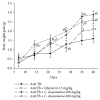Hepatoprotective and Anti-Inflammatory Activities of the Cnidoscolus chayamansa (Mc Vaugh) Leaf Extract in Chronic Models
- PMID: 30147729
- PMCID: PMC6083640
- DOI: 10.1155/2018/3896517
Hepatoprotective and Anti-Inflammatory Activities of the Cnidoscolus chayamansa (Mc Vaugh) Leaf Extract in Chronic Models
Abstract
Previous report described that CHCl3:MeOH extract of C. chayamansa leaves and pure compounds (moretenol, moretenyl acetate, kaempferol-3,7-dimethyl ether, and 5-hydroxy-7-3',4'-trimethoxyflavanone) showed important topical and systemic anti-inflammatory activity in acute model, as well as in vitro antimycobacterial and antiprotozoal activities. In this paper, we describe the in vivo hepatoprotective and anti-inflammatory effects of the CHCl3:MeOH extract in chronic model and the isolation of additional compounds (moretenone and lupeol acetate). The hepatoprotective activity was determined at 39 days using Balb/c mice with liver damage induced with an antitubercular drug (RIF/INH/PZA). The anti-inflammatory activity was evaluated in a chronic model induced with CFA and in two acute models (TPA and carrageenan). In addition, moretenone and lupeol acetate were isolated and identified by spectroscopic data. Lupeol acetate is a main compound present in fractions 14-42, and this fraction was the majority fraction from the extract; from this moretenone was obtained. In animals with liver damage, the extract at 200 and 400 mg/kg induced better body weight gain with respect to positive control (Silymarin); in addition, the mice that received the extract at 200 mg/kg and Silymarin exhibited slight steatosis; however, the animals' livers at 400 mg/kg did not show steatosis. The extract and fractions 14-42 showed a good anti-inflammatory activity by TPA model (DE50 = 1.58 and 1.48 mg/ear) and by carrageenan model (DE50 = 351.53 and 50.11 mg/kg). In the chronic inflammatory test, the extract at three doses revealed a similar effect to that of phenylbutazone, although the body weight gain was better in animals that received the extract at 900 mg/kg. Conclusion. The CHCl3:MeOH extract showed significant anti-inflammatory and good hepatoprotective effect on chronic models. The fraction containing moretenone and lupeol acetate as main compounds was more active than extract in both acute models of inflammation.
Figures






Similar articles
-
Antiprotozoal, antimycobacterial, and anti-inflammatory evaluation of Cnidoscolus chayamansa (Mc Vaugh) extract and the isolated compounds.Biomed Pharmacother. 2017 May;89:89-97. doi: 10.1016/j.biopha.2017.02.021. Epub 2017 Feb 20. Biomed Pharmacother. 2017. PMID: 28222400
-
Additional compounds and the therapeutic potential of Cnidoscolus chayamansa (McVaugh) against hepatotoxicity induced by antitubercular drugs.Biomed Pharmacother. 2019 Sep;117:109140. doi: 10.1016/j.biopha.2019.109140. Epub 2019 Jul 4. Biomed Pharmacother. 2019. PMID: 31387195
-
Cnidoscolus chayamansa Mc Vaugh, an important antioxidant, anti-inflammatory and cardioprotective plant used in Mexico.J Ethnopharmacol. 2014 Feb 3;151(2):937-43. doi: 10.1016/j.jep.2013.12.004. Epub 2013 Dec 11. J Ethnopharmacol. 2014. PMID: 24333962
-
Anti-inflammatory and toxicological evaluation of Moussonia deppeana (Schldl. & Cham) Hanst and Verbascoside as a main active metabolite.J Ethnopharmacol. 2016 Jul 1;187:269-80. doi: 10.1016/j.jep.2016.04.033. Epub 2016 Apr 25. J Ethnopharmacol. 2016. PMID: 27125592
-
Anti-inflammatory, free radical scavenging and alpha-glucosidase inhibitory activities of Hamelia patens and its chemical constituents.Pharm Biol. 2016 Sep;54(9):1822-30. doi: 10.3109/13880209.2015.1129544. Epub 2016 Jan 5. Pharm Biol. 2016. PMID: 26731099
Cited by
-
Biotechnological processes to obtain bioactive secondary metabolites from some Mexican medicinal plants.Appl Microbiol Biotechnol. 2021 Aug;105(16-17):6257-6274. doi: 10.1007/s00253-021-11471-z. Epub 2021 Aug 20. Appl Microbiol Biotechnol. 2021. PMID: 34415391 Review.
-
In Silico Study, Physicochemical, and In Vitro Lipase Inhibitory Activity of α,β-Amyrenone Inclusion Complexes with Cyclodextrins.Int J Mol Sci. 2021 Sep 13;22(18):9882. doi: 10.3390/ijms22189882. Int J Mol Sci. 2021. PMID: 34576044 Free PMC article.
-
Nutritional Value, Ethnopharmacology, Chemistry, and Biological Activities of Species of the Genus Cnidoscolus: An Updated Review.Foods. 2025 Jun 13;14(12):2092. doi: 10.3390/foods14122092. Foods. 2025. PMID: 40565700 Free PMC article. Review.
-
The Antioxidant Activity of Atomized Extracts of the Leaves and Stems of Cnidoscolus diacanthus (Pax & K. Hoffm.) J.F. Macbr. from Peru and Their Effect on Sex Hormone Levels in Rats.Molecules. 2024 Sep 25;29(19):4554. doi: 10.3390/molecules29194554. Molecules. 2024. PMID: 39407486 Free PMC article.
References
-
- Pérez-González M., Gutiérrez-Rebolledo G., Jiménez-Arellanes M. Importancia nutricional, farmacológica y química de la chaya (Cnidoscolus chayamansa) Temas de Ciencia y Tecnologia. 2016;20(6):43–56.
-
- Pérez-González M. Z., Gutiérrez-Rebolledo G. A., Yépez-Mulia L., Rojas-Tomé I. S., Luna-Herrera J., Jiménez-Arellanes M. A. Antiprotozoal, antimycobacterial, and anti-inflammatory evaluation of Cnidoscolus chayamansa (Mc Vaugh) extract and the isolated compounds. Biomedicine & Pharmacotherapy. 2017;89:89–97. doi: 10.1016/j.biopha.2017.02.021. - DOI - PubMed
-
- Kulathuran Pillai K., Chidambaranathan N., Mohamed Halith M., Jayaprakash S., Narayanan N. Hepatoprotective activity of Cnidoscolus chayamansa against rifampicin and isoniazide induced toxicity in wistar rats. Research Journal of Pharmaceutical, Biological and Chemical Sciences. 2012;3(2):577–585.
LinkOut - more resources
Full Text Sources
Other Literature Sources

